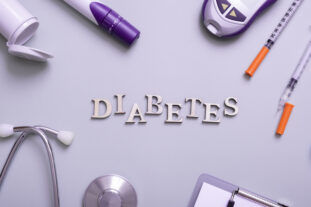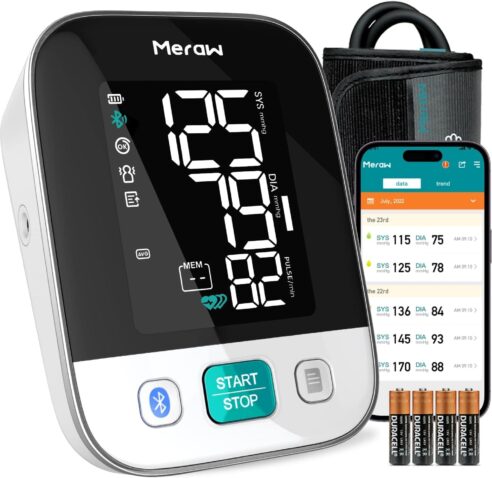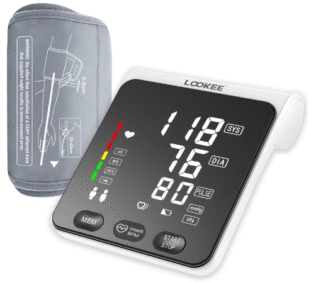Understanding signs and symptoms in diabetes can be a matter of life and death – literarily! Diabetes can sneak up on you, especially in its early stages, when symptoms might be subtle or even nonexistent.
Knowing what to look for can help you catch it early and take action. This article presents common signs and symptoms in diabetes that you need to be aware of and the importance of regular monitoring of blood pressure at home.
Common Signs and Symptoms in Diabetes
Whether it’s Type 1 or Type 2 diabetes, there are some telltale signs of diabetes and symptoms to watch for. There are at least 7 common symptoms of note.
Frequent Urination – If you find yourself running to the bathroom more often, especially at night, it could be a red flag. High blood sugar causes your kidneys to work overtime to filter and remove excess sugar, leading to increased urination.
Increased Thirst – With all that extra urination, your body gets dehydrated. This can leave you feeling parched, no matter how much water you drink.
Excessive Hunger – Feeling hungry even after eating? It’s because your body struggles to convert the glucose in your blood into energy, leaving your cells craving more fuel.

Fatigue – Diabetes messes with your body’s ability to get energy from food. As a result, you might feel unusually tired or drained, even after a good night’s sleep.
High Blood Pressure – This occurs when the force of blood pushing through your vessels is consistently too high – at or above 130/80 mm Hg. If untreated, it can lead to serious health issues like heart attack and stroke.
Blurred Vision – High blood sugar can affect the lenses in your eyes, leading to blurry or distorted vision. Left untreated, this can cause long-term damage.
Slow-Healing Wounds or Frequent Infections – Cuts, sores, or bruises that take longer than usual to heal can indicate diabetes. High blood sugar impairs your immune system and circulation, making recovery slower.
Tingling, Numbness, or Pain in Hands and Feet – Also known as peripheral neuropathy, this symptom happens because high blood sugar damages your nerves over time.
Other Signs and Symptoms in Diabetes – These are listed under symptoms specific to type 1 diabetes and symptoms specific to type 2 diabetes.
Type 1 Diabetes and Symptoms
Type 1 diabetes often develops quickly and tends to show up in childhood or adolescence, though it can also occur in adults.
Watch for these additional symptoms: rapid onset of severe symptoms and ketones in the urine which can be detected by a test. This happens when the body breaks down fat for energy.
Unexplained weight loss is more common in Type 1. If you are loosing pounds without trying, it could be because your body is burning fat and muscle for energy instead of using glucose.
Type 2 Diabetes and Symptoms
Type 2 diabetes develops more gradually, and many people don’t even realize they have it. In addition to the common symptoms listed above, watch for darkened skin patches which is often found around the neck, armpits, or groin, along with mild symptoms that worsen over time, as the condition progresses.
What are the Signs of Prediabetes?
Prediabetes is the stage before diabetes, and while symptoms are often absent, some pointers include mild fatigue or sluggishness, skin tags or darkened skin patches on the neck or armpits, and a slightly elevated blood sugar levels during routine blood work.
If you notice any of these symptoms, do not ignore them. Reach out to a healthcare provider for a discussion about your family history and lifestyle risk factors. They will also request for a fasting blood sugar test or A1C test.
By recognizing these symptoms and acting early, you can take control of your health and prevent complications.
If something feels off, trust your gut and seek professional advice—early intervention can make all the difference!
9 Risks of Ignoring Diabetes and High Blood Pressure
Ignoring diabetes and high blood pressure is like letting a small leak in your roof go unchecked—it might seem manageable at first, but over time, it can lead to significant damage.
When diabetes and high blood pressure occur together, they create a perfect storm.
These two conditions are often called “silent killers” because they can progress without noticeable symptoms until complications arise. If you ignore them, it can result in:
Accelerated damage: High blood sugar and high pressure combine to damage blood vessels faster and more extensively.
Compounded risks: The likelihood of plaque buildup, clots, and weakened vessels skyrockets.
The combination also makes recovery from a stroke more challenging, as diabetes can slow the healing process.
Heart Disease and Stroke
Both diabetes and high blood pressure put extra strain on your heart and blood vessels.
Over time, this increases your risk of coronary artery disease (blocked or narrowed arteries), heart attack, and stroke due to damaged blood vessels or clots.
Cardiovascular disease is the leading cause of death in people with diabetes and hypertension.
High blood sugar damages the walls of blood vessels, making them prone to buildup (atherosclerosis) and high blood pressure accelerates this damage, increasing the likelihood of clots and blockages.
Regularly monitoring your blood pressure at home
Kidney Damage (Diabetic Nephropathy)
Your kidneys filter waste from your blood, but both conditions can damage these vital organs. Diabetes can harm the small blood vessels in the kidneys, reducing their ability to function.
High blood pressure puts additional stress on the kidneys, worsening the damage. If left untreated, this can lead to chronic kidney disease or even the need for dialysis.
Persistent high blood sugar and hypertension lead to scarring in the kidney’s filtering units, potentially causing kidney failure over time.
Vision Problems (Diabetic Retinopathy)
High blood sugar and high blood pressure can damage the tiny blood vessels in the eyes, leading to blurred vision, retinal detachment, and complete vision loss.
Vision loss from these conditions can be permanent if not addressed early.
Diabetes damages the delicate blood vessels in the retina, causing them to leak or bleed. High blood pressure exacerbates this damage, increasing the risk of complications.
Nerve Damage (Neuropathy)
High blood sugar damages nerves throughout the body, and high blood pressure reduces the blood flow needed to keep those nerves healthy. Symptoms include tingling, numbness, burning pain, or weakness, particularly in the hands and feet.
Autonomic neuropathy can affect the digestive system, bladder, or heart. In severe cases, this can lead to mobility issues, injuries due to loss of sensation, or complications requiring amputation.
Prolonged exposure to high blood sugar and blood pressure reduces the nutrients reaching the nerves.
Cognitive Decline and Dementia
Did you know that diabetes and high blood pressure can negatively affect the brain? They increase the risk of vascular dementia (caused by reduced blood flow to the brain).
Chronic inflammation linked to diabetes can contribute to Alzheimer’s disease. If untreated, this can lead to memory loss, confusion, and reduced quality of life.
Furthermore, damage to blood vessels in the brain reduces oxygen and nutrient delivery, impairing cognitive function.
Peripheral Artery Disease (PAD)
Diabetes and high blood pressure can cause narrowing of the blood vessels in your legs and feet.
This reduces blood flow, causing pain or cramping during walking or physical activity. Damaged arteries restrict circulation, and high blood sugar slows healing.
Wounds on the feet may heal poorly, increasing the risk of infections.The result? Severe PAD can lead to gangrene and the need for amputation.
Gestational Diabetes Signs and Symptoms – Excludes seniors
Gestational diabetes and pregnancy-induced hypertension can pose serious risks to both the mother and baby. Mothers are at higher risk for preeclampsia (a dangerous rise in blood pressure).
It is caused by hormonal changes during pregnancy which make it harder to manage blood sugar and blood pressure.
Babies on the other hand may have a higher birth weight, leading to complications during delivery. In severe cases, complications can endanger both mother and fetal health.
Increased Risk of Infections
Both conditions weaken your immune system. High blood sugar provides a breeding ground for bacteria and fungi. Poor circulation from high blood pressure makes it harder for your body to heal wounds and fight infections.
This increases your risk for skin infections, urinary tract infections, and foot ulcers.
Mental Health Struggles
Living with unmanaged diabetes and high blood pressure can take a toll on your mental health. Anxiety and depression are common especially if complications arise.
The physical and emotional burden of these conditions can lead to feelings of helplessness and frustration.
Stress can worsen blood sugar and blood pressure levels, creating a vicious cycle. Furthermore, poor mental health can make it harder to stick to treatment plans, exacerbating the risks.
Final Thoughts – Diabetes and Symptoms
Ignoring diabetes and high blood pressure is risky business. These conditions might start quietly, but over time, they can lead to life-altering complications. The good news?
Many of these risks can be avoided or minimized with early detection, consistent management, and a proactive approach to your health.
A stroke is a devastating event, but it is largely preventable. By managing diabetes and high blood pressure, you can significantly reduce your risk.
The key is early intervention, a healthy lifestyle, and consistent medical care. Take action today—your brain will thank you!
Don’t wait for diabetes and symptoms to escalate. Take charge today by monitoring your health, making lifestyle changes, and working closely with your healthcare provider.
Related Articles
- Diabetes and Blood Pressure: 4 Connections
- The Best Diabetic Cookbooks – 12 Great Options
- 8 Effective Home Remedies to Lower Diabetes
- Type 2 Diabetes in Seniors: Symptoms and Proven Tips
- Uncontrolled Diabetes and the Brain -8 Deadly Effects
FAQ for Diabetes and Symptoms
What are the early signs and symptoms in diabetes?
Early signs include frequent urination, extreme thirst, fatigue, blurred vision, and slow-healing wounds. Unexplained weight loss and increased hunger can also indicate diabetes.
What are the symptoms of high blood sugar in diabetes?
Symptoms of high blood sugar (hyperglycemia) include increased thirst, frequent urination, headaches, blurred vision, fatigue, and dry mouth. Prolonged high levels can lead to serious complications.
How is diabetes-related fatigue different from regular tiredness?
Diabetes fatigue is persistent and often linked to fluctuating blood sugar levels. Unlike regular tiredness, it may not improve with rest and can significantly affect daily activities.





